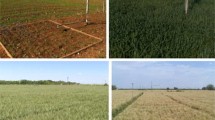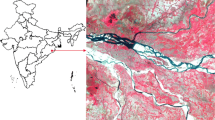Abstract
Field studies were conducted on differentially irrigated wheat (Cv. ‘Sonalika’), on a sandy loam soil at Indian Agricultural Research Institute, New Delhi to evaluate the surface energy balance evapotranspiration (ET) models which use remotely sensed canopy temperature as an input. Four energy balance ET models were used in this study viz. Jackson et. al. (1977) approach; Bartholic et. al. (1970) and stability corrected and uncorrected aerodynamic resistance forms of models. To test the model, ET was estimated using remotely sensed canopy temperatrue, with the remaining to ET measured by water depletion method. Aerodynamic resistance forms of ET models performed well as compared to other models. Results indicate that remotely sensed canopy temperature as an input to surface energy balance models, offers a potential method of estimating ET from a cropped surface.
Similar content being viewed by others
References
Bartholic, J.F., Namken, L.N., and Wiegand, C.L., (1970), Combinations equations used to calculate evaporation and potential evaporation. USDA-ARS-Bull. 41–170, pp. 14.
Blad, B.L., and Rosenberg, N.J., 1976, Evaluation of resistance and mass transport evapotranspiration models requiring canopy temperature data, Agron. J., V. 69, pp. 764–769.
Brown, K.W., and Rosenberg, N.J., 1973, A resistance model to predict evapotranspiration and its application to sugar beet field, Agron. J. V., 65, pp. 341–347.
Gupta, P.L., and Sastry, P.S.N., 1984, Remotely sensed canopy temperature based models for estimating evapotranspiration, Proc. 5th Asian Conference on Remote Sensing, Kathmandu (Nepal), pp. P-7-1 to p-7-7.
Hatfield, J.L. Reginato, R.J., and Idso, S.B., 1984, Evaluatior. of canopy temperature — Evapotranspiration models over various crops, Agric. For Meteorol., V. 32, pp. 41–53.
Heilman, J.L., and Kanemasu, E.T., 1976, An Evaluation of a resistance form of energy balance to estimate evapotranspiration, Agron. J., V. 68, pp. 607–611.
Jackson, R.D., Reginato, R.J., and Idso, S.B., 1977, Wheat canopy temperatures: a practical tool for evaluating water requirements, Water Resour. Res., V. 13, pp. 651–656.
Michael, A.M., 1978, Irrigation: Theory and practice, Vikas Publishing. House, New Delhi (India).
Monteith, J.L., 1973, Principle of Environmental Physics, Edward Arnold, London, pp. 241.
Saha, S.K., Ajai, Kamat, D.S., Singh, A.K., Aggarwal, P.K., Chaturvedi, G.S., and Sinha, S.K., 1984, Remote Sensing of crop evapotranspiration using plant canopy temperature, proc. Seminar on Crop growth condition and remote sensing, New Delhi, pp. 1-2-1 to 1-2-11.
Seguin, B., and Itier, B., 1983, Using midday surface temperature to estimate daily evaporation from satellite thermal IR data, Int. J. Remote Sens., V. 4, pp. 371–384.
Soer, G.J.R., 1980, Estimation of regional evapotranspiration and soil moisture conditions using remotely sensed crop surface temperatures. Remote Sens. Environ., V. 9, pp. 27–45.
Stone, L.R., and Horton, M.L., 1974, Estimating evapotranspiration using canopy temperatures: field evaluation, Agron. J., V. 66, pp. 450–454.
Author information
Authors and Affiliations
About this article
Cite this article
Saha, S.K., Ajai Remotely sensed canopy temperature based evapotranspiration models for wheat. Jour.Ind.Soc. Remote Sensing 14, 87–97 (1986). https://doi.org/10.1007/BF03007234
Issue Date:
DOI: https://doi.org/10.1007/BF03007234




